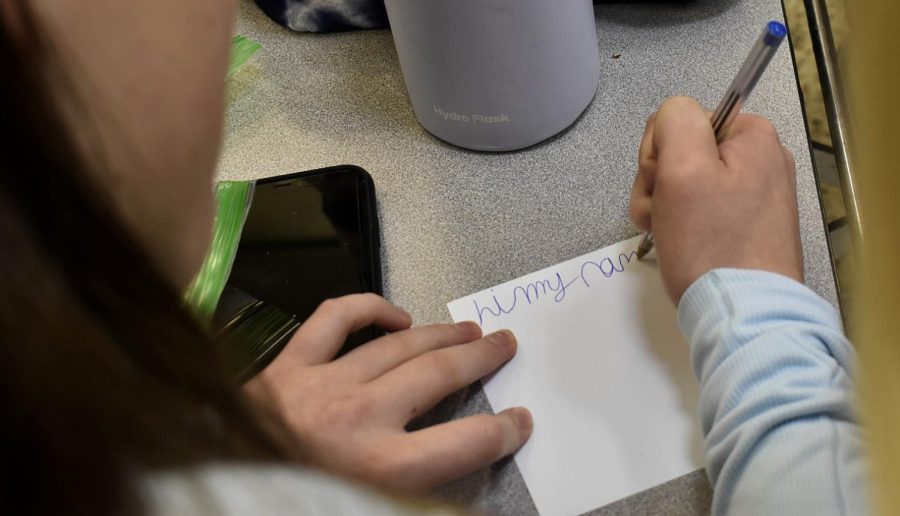The lost art of writing in cursive
Photo by: Kyle Reeder
Growing up in the United States, children in elementary schools are taught the basics to writing neat, clean and effectively. However, only a handful of these United States’ elementary schools actually teach cursive alongside normal print. Over past few years, as the world begins to transition into a more modern world, where quick-clicking keyboard and rapid-typing texters are the new norm, it has become uncommon for students to revert to a pen and paper alternative, let alone in cursive.
The topic of cursive writing has since become a long-heated debate in the classroom of whether students should continue to learn it, with growing fears that upcoming generations will struggled to read important documents such as the Declaration of Independence or even a birthday cards from a relative, and most of all, signing a signature. So, how current is cursive? Here’s what we found.
At a lunch table full of students, pens and papers were distributed. Each student was given the task to write “hello” followed by a self-introduction, completely in cursive. Many were taken aback by the proposal as many questioned their skills of the “unknown language.” With pens gripped tightly in-hand, students struggled to write a basic sentence. Many laughed at their friends, pointing to their monstrous creations, but only a select few were able to write in a legible script.
“I never learned it,” Jessica Sawyer, 10, said after participating in the experiment. “Cursive is old school, and we’re in a new time.”
“I wish I knew it actually,” Izzie Clayborn, 9, said. “All I can write is my name, and everything else just kind of looks sad.”
A majority of students blame their elementary schools, who chose to skip out on the cursive curriculum. Those who were lucky enough to be exposed to the script while in elementary school, can still perform their skills.
“I know cursive because my elementary school taught it for a week,” Riley Keys, 12, said. “Somehow I still know how to do it. I feel like it’s so unimportant. It’s like a different form of font,” Keys said.
Many argue that cursive has become ultimately irrelevant and that schools should focus on typing rather than trying. “I think it’s more important to learn to type correctly than to learn to write cursive,” Ava Uzar, 9, said.
“I think it’s important only for signatures,” Ethan Davies, 9, said. “I don’t know how to read fancy documents.”
However, others argue that the dying art should continue to be taught and practiced. It has been proven in many ways that cursive has lead to a stronger brain and helps delay dyslexia.
“I think it’s important so when my grandparents send me cards I am able to read them,” Dani Marmo, 12, said.
“Its important so you can read other people’s handwriting,” Ruby Stumph, 9, said. “It’s good to know, but it’s not vital.”
“It’s very important,” Midlo Parent, Shelli Land-Pauson, said. “There’s plenty of studies that show that a child’s cognitive abilities are directly tied to putting pen to paper with zero interruptions. By zero interruptions I mean, when you print you pick up your pencil to start the next letter, but cursive is a constant flow. There is direct correlation between a child’s cognitive development and their ability to write in cursive,” Land-Pauson said.
In the end, the topic is forever debatable, but one thing is certain, the number of students who know cursive will only continue to decline as the world slowly turns from cursive to computer.

Kyle Reeder, Class of 2023
Kyle Reeder has been on staff for four years and is the Multi-Media Editor. Outside of school, he runs cross country and...




